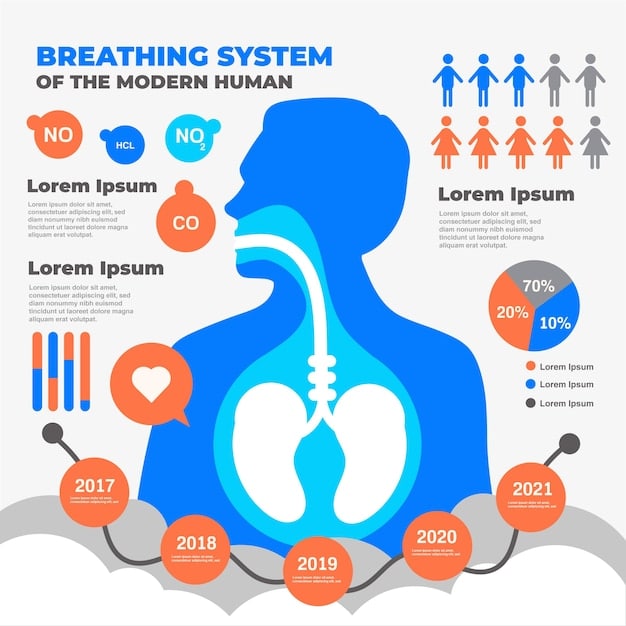Reduce Stress: Master the 4-7-8 Breathing Technique in Minutes

The 4-7-8 breathing technique is a simple yet powerful method that can significantly reduce stress in just five minutes by promoting relaxation and balancing the nervous system through controlled breathing patterns that decrease heart rate and calm the mind.
Feeling overwhelmed? Discover How Can the 4-7-8 Breathing Meditation Technique Reduce Stress by 25% in Just 5 Minutes? This simple breathing exercise can be a game-changer for managing stress and anxiety.
Understanding the 4-7-8 Breathing Technique
The 4-7-8 breathing technique, also known as the relaxing breath, is a breathing pattern designed to bring the body into a state of deep relaxation. It’s a simple yet effective method that can be practiced virtually anywhere, making it a valuable tool for managing stress and anxiety.
This technique involves inhaling for a count of 4, holding the breath for a count of 7, and exhaling for a count of 8. This specific pattern is believed to slow the heart rate, reduce blood pressure, and release tension in the body.
The Science Behind the Breath
The 4-7-8 breathing technique works by influencing the parasympathetic nervous system, which is responsible for the body’s “rest and digest” response. When you’re stressed, your sympathetic nervous system kicks into high gear, increasing heart rate and blood pressure. Controlled breathing can counteract this by activating the parasympathetic nervous system.
Benefits Beyond Stress Reduction
While stress reduction is a primary benefit, the 4-7-8 breathing technique can also improve sleep quality, reduce anxiety symptoms, manage cravings, and even control anger responses. Its versatility makes it a valuable technique for overall well-being.
- Reduces Anxiety: By calming the nervous system, it can help alleviate anxiety symptoms.
- Improves Sleep: Practicing before bed can promote relaxation and improve sleep quality.
- Manages Cravings: Can help reduce the intensity of cravings by providing a distraction and promoting relaxation.
- Controls Anger: Provides a calming effect that can help manage anger responses.
In essence, the 4-7-8 breathing technique is a powerful tool for tapping into the body’s natural relaxation response, providing a quick and effective way to manage stress and improve overall well-being. It’s a skill that, with practice, can become a go-to method for navigating life’s daily stressors.
Step-by-Step Guide to Performing the 4-7-8 Breath
Mastering the 4-7-8 breathing technique is simple and requires no special equipment or environment. Follow these easy steps to learn how to perform this stress-reducing breath:
Before you begin, find a comfortable position. You can sit in a chair with your feet flat on the ground or lie down on your back. The key is to be relaxed and free from distractions.
Detailed Instructions
- Get Comfortable: Sit or lie down in a relaxed position.
- Place the Tip of Your Tongue: Gently place the tip of your tongue against the ridge of tissue just behind your upper front teeth, and keep it there throughout the exercise.
- Exhale Completely: Completely exhale through your mouth, making a whooshing sound.
- Close Your Mouth and Inhale: Close your mouth and inhale quietly through your nose to a mental count of four.
- Hold Your Breath: Hold your breath for a count of seven.
- Exhale Completely Through Your Mouth: Exhale completely through your mouth, making a whooshing sound to a count of eight.
- Repeat: This is one breath. Now inhale again and repeat the cycle three more times for a total of four breaths.
Tips for Success
Keep your tongue in the correct position throughout the exercise. Focus on the count, and try to maintain a steady rhythm. If you feel lightheaded, slow down the breathing or take a break. It’s also important not to rush the exhalation process.

By following these steps and tips, you can effectively perform the 4-7-8 breathing technique and experience its stress-reducing benefits. With regular practice, this technique can become a natural and effortless way to calm your mind and body.
Incorporating 4-7-8 Breathing Into Your Daily Routine
The beauty of the 4-7-8 breathing technique lies in its simplicity and accessibility. It can be easily incorporated into your daily routine to manage stress and promote relaxation whenever and wherever you need it.
Consider setting aside specific times each day to practice the 4-7-8 breath. This could be in the morning to start your day calmly, during your lunch break to de-stress, or before bed to improve sleep quality.
Specific Times to Practice
Morning practice can set a positive tone for the day, while midday practice can help you manage workplace stress. Evening practice promotes relaxation and prepares you for a restful night’s sleep.
Making it a Habit
To make the 4-7-8 breathing technique a regular habit, try pairing it with existing routines, such as brushing your teeth or waiting for your coffee to brew. Setting reminders on your phone or using a habit-tracking app can also help solidify the practice.
- Morning Routine: Start your day with a few cycles to set a calm tone.
- Lunch Break: Use it as a quick stress reliever during your break.
- Before Bed: Practice to relax and improve sleep quality.
- During Stressful Moments: Employ it whenever you feel overwhelmed.
By incorporating the 4-7-8 breathing technique into your daily life, you can create a consistent practice that helps you manage stress, improve sleep, and enhance your overall well-being. The key is to start small and gradually integrate it into your routine until it becomes a natural part of your day.
Measuring the Impact: Can it Really Reduce Stress by 25%?
While the specific figure of reducing stress by 25% in just 5 minutes is an estimate, many studies and anecdotal evidence suggest that the 4-7-8 breathing technique can significantly lower stress levels in a short amount of time.
The effectiveness of the 4-7-8 breathing technique depends on various factors, including individual physiology, consistency of practice, and the specific stressors being faced. However, the underlying principles of controlled breathing and relaxation provide a solid foundation for stress reduction.
Understanding the Research
Research indicates that controlled breathing exercises can lower cortisol levels (the stress hormone), reduce heart rate, and promote a sense of calm. These physiological changes contribute to an overall reduction in stress and anxiety.
Real-World Examples
Many people who regularly practice the 4-7-8 breathing technique report feeling more relaxed, centered, and less reactive to stressors. These personal experiences underscore the potential of this technique to make a tangible difference in daily life.

Although individual results may vary, the 4-7-8 breathing technique offers a promising and accessible method for managing stress and improving overall well-being. Its ease of use and potential benefits make it a valuable tool for anyone seeking to reduce stress and enhance their quality of life.
Potential Challenges and How to Overcome Them
While the 4-7-8 breathing technique is generally safe and accessible, some people may encounter challenges when first learning and practicing it. Understanding these potential obstacles and knowing how to overcome them can help ensure a positive and effective experience.
Common challenges include feeling lightheaded, difficulty holding the breath, and struggling to maintain focus. These issues are often temporary and can be addressed with simple adjustments and consistent practice.
Lightheadedness and Dizziness
If you experience dizziness or lightheadedness, slow down your breathing, reduce the duration of breath holds, or take a break. It’s also important to ensure you’re in a comfortable position and not hyperventilating.
Difficulty Holding the Breath
If you find it challenging to hold your breath for a count of seven, start with a shorter hold and gradually increase the duration as you become more comfortable. The goal is to find a rhythm that feels sustainable and relaxing.
- Start Slowly: Begin with shorter breath holds and gradually increase.
- Practice Regularly: Consistency builds comfort and proficiency.
- Stay Hydrated: Ensure you are adequately hydrated to avoid dizziness.
- Listen to Your Body: Adjust the technique based on your comfort level.
By being aware of these potential challenges and implementing practical solutions, you can overcome obstacles and fully benefit from the 4-7-8 breathing technique. Consistent practice and self-awareness are key to mastering this technique and integrating it into your stress-management toolkit.
Combining 4-7-8 Breathing with Other Stress-Reduction Methods
While the 4-7-8 breathing technique is a powerful tool on its own, its effectiveness can be enhanced by combining it with other stress-reduction methods. Integrating multiple approaches can create a more comprehensive and personalized stress-management plan.
Consider pairing the 4-7-8 breath with practices such as mindfulness meditation, yoga, or progressive muscle relaxation for synergistic effects.
Mindfulness Meditation
Mindfulness meditation involves focusing on the present moment without judgment. Combining this with the 4-7-8 breath can deepen relaxation and increase self-awareness.
Yoga
Yoga combines physical postures, breathing techniques, and meditation to promote overall well-being. Integrating the 4-7-8 breath into your yoga practice can enhance its calming and stress-reducing benefits.
By combining the 4-7-8 breathing technique with other stress-reduction methods, you can create a personalized and holistic approach to managing stress and enhancing your overall well-being. Experiment with different combinations to find what works best for you.
| Key Point | Brief Description |
|---|---|
| 🧘 Breathing Pattern | Inhale for 4, hold for 7, exhale for 8. |
| ⏱️ Time Investment | Just 5 minutes can promote relaxation. |
| 🧠 Nervous System | Activates the parasympathetic system. |
| 😴 Sleep Aid | Practice before bed for better sleep. |
Frequently Asked Questions
▼
You can practice the 4-7-8 breathing technique as often as you like, even multiple times a day. Some people find it helpful to do it several times throughout the day, especially during moments of stress or anxiety.
▼
Yes, the 4-7-8 breathing technique can be a helpful tool for managing panic attacks. By slowing down your heart rate and calming your nervous system, it can help reduce the intensity and duration of a panic attack.
▼
If you have asthma, it’s generally safe to practice the 4-7-8 breathing technique. However, it’s essential to listen to your body and stop if you experience any difficulty breathing or discomfort. Consult with your doctor if you have concerns.
▼
Many people experience immediate relaxation and stress reduction after just a few cycles of the 4-7-8 breathing technique. With regular practice, you may notice more significant and long-lasting benefits over time.
▼
Yes, children can safely practice the 4-7-8 breathing technique. It can be a valuable tool for helping children manage stress, anxiety, and improve sleep. It’s best to teach them in a calm and supportive environment.
Conclusion
In conclusion, the 4-7-8 breathing technique offers a simple, accessible, and effective method for reducing stress and promoting overall well-being. Whether you’re looking to manage daily stressors, improve sleep, or enhance your mindfulness practice, incorporating this technique into your routine can provide significant benefits. With consistent practice, you can harness the power of your breath to create a calmer, more balanced life.





